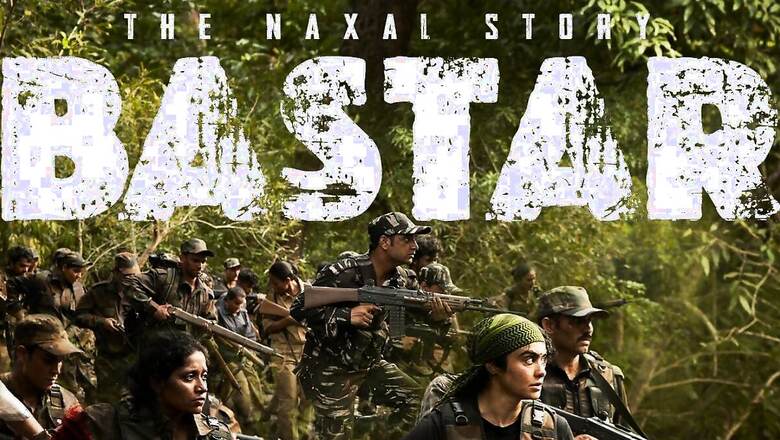
views
Bastar- The Naxal Story Review: Dark, gory, gritty and violent, the premise of Sudipto Sen’s Bastar: The Naxal Story aims to bring out the visceral chapters of Naxalite–Maoist insurgency in the district of Bastar in Chhattisgarh. While the makers are ought to be applauded for meticulously depicting the agonizing past of Bastar, they ambiguously try to pin the blame elsewhere. And that dilutes the grim and mournful plight of those who have witnessed the bloodshed firsthand. Having said that, Bastar: The Naxal Story excels in its production quality, with all the alleged conspiracies sneakily placed between scenes and dialogues, the movie might leave you shell-shocked in several places.
The film takes off with an intense courtroom scene between two lawyers Neelam Nagpal and Utpal Trivedi, played by Shilpa Shukla and Yashpal Sharma respectively. From the get-go, it’s conveyed that Shilpa Shukla’s character is accusing IPS Neerja Bhargava (played by Adah Sharma) of carrying out extra-judicial encounters on innocent tribal and dragging a reputed author Vanya Roy (played by Raima Sen) under suspicion of being an outside conspirator in Naxalite violence. Meanwhile, Yashpal Sharma expostulates on behalf of Neerja but finds himself overpowered by Shilpa Shukla’s assertion.
The scene shifts to a quaint village, somewhere in Bastar, where a group of tribal people are hoisting the Tricolour. They get ambushed by some Naxalites, who whisk away a person named Milind Kashyap (played by Subrata Dutta) along with his wife Ratna (played by Indira Tiwari), a son and a daughter. They are escorted to a guerrilla camp, governed by a notorious and presumably silver-tongued leader by the name Comrade Reddy (played by Vijay Krishna), who is accompanied by another female leader who is as ruthless as him. The camp itself is depicted as the hotbed of rebellion, training, sophisticated ammunition and other important resources.
In what seems to be an unconstitutional tribunal, the Naxals declare Milind a traitor for hoisting the Tricolour and being an informer for IPS Neerja Bhargava. And what follows is a gruesome and grotesque execution of Milind, where Reddy hacks one of his hands with an axe and proceeds to brutally mutilate him in front of his ululating wife and his traumatized daughter. To add to their sorrows, they snatch away his son, who seems to be motivated by one of Reddy’s speeches.
Fuelled with revenge, Milind’s wife Ratna, with some motivation from Neerja Bhargava, picks herself up and vows to annihilate the cold-blooded murderers of her husband. And that initiates the grisly tussle, not only between the Naxals and the military, but also certain proxies, that have been portrayed being in cahoots with the extremist group.
Bastar: The Naxal Story tries to tow the line between fiction and real life but ends up being a hodgepodge of conspiracies. In a scene, an individual by the name of Narayan Bagchi, who is later revealed to be a distinguished professor of a university can be seen urging Raima Sen’s character to infiltrate the ranks of academics, and Bollywood with the ideology of left extremism.
Another segment shows a very crass depiction of a university, quite similar to one in New Delhi. Through a parody-like music video, the makers allege that this particular university and its students are celebrating the sickening massacre of 76 Jawans in the naxal-infested Dantewada. To add an extra layer of depravity in their depiction, one of the students is shown referring to the slain Jawans as ‘dogs’, and other students clapping in unison, while holding their placards.
The flagrant targeting doesn’t stop there as Adah Sharma’s character, towards the end of the movie breaks into a seething monologue, where she expresses to shoot down the left-liberals, without any fear of capital punishment. Others might argue that it is just a dialogue of an impassioned cop, but it sets a very dangerous precedent for the audience.
There is also an uncomfortable amount of unnecessary, exaggerated gore that the makers have added in several scenes. While the motive behind it is incoherent to me, the morbid obsession with the gnarly portrayal gives off a voyeuristic streak to the narrative. There is a scene where an insurgent picks up a toddler and throws her onto a burning rooftop, and we could hear her screams fade into the crackling din of fire. The film is packed with several disturbing scenes like this one and there is no limit to it.
However, one of the major takeaways from Bastar: The Naxal Story are the performances by actors like Adah Sharma, Yashpal Sharma, Shilpa Shukla, Raima Sen, Purnendu Bhattacharya and others. Each of them have played their part well especially Adah Sharma and Vijay Krishna. The production quality of the film excels in every department, right from the action sequences to cinematography and VFX as well as locations. There is also a lot of emotional depth between Ratna and her son. The makers also succeed in capturing the apathy of tribal who often finds themselves stuck between police officers and insurgents, with pressure mounting from both sides.
But overall, this Sudipto Sen’s directorial falls flat, mostly due to the film’s lack of ingenuity and structure towards the Naxalite insurgency in Bastar and a meandering narrative that has a little to offer except shock and gore.




















Comments
0 comment